
As of 2021, the House of Representatives of Japan is elected from a combination of multi-member districts and single-member districts, a method called Parallel voting. Currently, 176 members are elected from 11 multi-member districts (called proportional representation blocks or PR blocks) by a party-list system of proportional representation (PR), and 289 members are elected from single-member districts, for a total of 465. 233 seats are therefore required for a majority. Each PR block consists of one or more prefectures, and each prefecture is divided into one or more single-member districts. In general, the block districts correspond loosely to the major regions of Japan, with some of the larger regions (such as Kantō) subdivided.
History
| This article is part of a series on |
| Politics of Japan |
|---|
 |
|
|
Until the 1993 general election, all members of the House of Representatives were elected in multi-member constituencies by single non-transferable vote. In 1994, Parliament passed an electoral reform bill that introduced the current system of parallel voting in single-member constituencies and proportional voting blocks.[1] The original draft bill in 1993 by the anti-LDP coalition of Prime Minister Morihiro Hosokawa included proportional party list voting on a national scale, an equal number of proportional and district seats (250 each) and the possibility of split voting. However, the bill stalled in the House of Councillors.[2] After the Liberal Democratic Party (LDP) had returned to power later that year, it was changed to include proportional voting in regional blocks only, the number of proportional seats was reduced, but the possibility to cast two separate votes was kept in the bill. The electoral reform law was finally passed in 1994. It was first applied in the 1996 general election.
Redistricting and reapportionment
Amendments to the electoral law in 2002[3] and 2013[4] changed the boundaries of single-member districts and reapportioned seats between prefectures (+5/-5 in 2002; +0/-5 in 2013, resulting in a net change of -5 in district seats in the House of Representatives to 295 and overall seats to 475). The borders of the regional proportional blocks have never changed, but the apportionment of seats to the regional proportional blocks changed in 2000 after the number of proportional seats had been reduced from 200 to 180 (reducing the total number of seats in the lower house from 500 to 480),[5] and in the 2002 reapportionment.
Another reapportionment was passed by the National Diet in June 2017. In the majoritarian segment, it will change 97 districts in 19 prefectures, six are eliminated without replacement (one each in Aomori, Iwate, Mie, Nara, Kumamoto and Kagoshima). In the proportional segment, four "blocks" lose a seat each (Tōhoku, N. Kantō, Kinki, Kyūshū). Thus, the number of majoritarian seats is reduced to 289, the number of proportional seats to 176, the House of Representatives overall shrinks to 465. The reform takes effect one month after promulgation, i.e. on July 16, 2017.[6][7]
Hokkaidō (8 block seats)
The block constituency for Hokkaidō (比例北海道ブロック) elects 8 members proportionally. It contains only Hokkaidō Prefecture, which is divided into 12 single-member districts.
Hokkaidō Prefecture (12 districts)
Tohoku (13 block seats)
The block constituency for Tohoku (比例東北ブロック) elects 14 members proportionally. It corresponds to the Tohoku region.
Akita Prefecture (3 districts)
| District | Areas included | Number of constituents[8] | Current representative | Party represented | Map |
|---|---|---|---|---|---|
| District 1 | City of Akita | 260,836 | Hiroyuki Togashi[10] | LDP |  |
| District 2 | Cities of Katagami, Kazuno, Kitaakita, Noshiro, Ōdate and Oga
Districts of Kazuno, Kitaakita, Minamiakita and Yamamoto |
255,369 | Takashi Midorikawa[9] | CDP | |
| District 3 | Cities of Daisen, Nikaho, Semboku, Yokote, Yurihonjō and Yuzawa | 316,428 | Nobuhide Minorikawa[9] | LDP | |
Aomori Prefecture (3 districts)
| District | Areas included | Number of constituents[8] | Current representative | Party represented | Map |
|---|---|---|---|---|---|
| District 1 | Cities of Aomori and Mutsu
District of Higashitsugaru, Shimokita and part of district of Kamikita |
338,948 | Akinori Eto[17] | LDP |  |
| District 2 | Cities of Hachinohe, Misawa and Towada
Part of district of Shimokita |
386,599 | Junichi Kanda[18] | LDP | |
| District 3 | Cities of Hirakawa, Hirosaki, Goshogawara, Kuroishi and Tsugaru
Districts of Kitatsugaru, Minamitsugaru, Nakatsugaru and Nishitsugaru |
344,106 | Jiro Kimura[18] | LDP | |
Fukushima Prefecture (4 districts)
| District | Areas included | Number of constituents[8] | Current representative | Party represented | Map |
|---|---|---|---|---|---|
| District 1[changed 1] | Cities of Date, Fukushima, Motomiya and Nihonmatsu | 389,027 | Emi Kaneko[18] | CDP |  |
| District 2[changed 1] | Cities of Kōriyama, Sukagawa and Tamura | 431,889 | Takumi Nemoto[11] | LDP | |
| District 3[changed 1] | Cities of Aizuwakamatsu, Kitakata and Shirakawa
District of Higashishirakawa, Kawanuma, Minamiaizu, Nishishirakawa, Ōnuma and Yama |
334,482 | Kōichirō Genba[19] | CDP | |
| District 4[changed 1] | Cities of Iwaki, Minamisōma and Sōma | 408,290 | Shinji Oguma[15] | CDP | |
Iwate Prefecture (3 districts)
| District | Areas included | Number of constituents[8] | Current representative | Party represented | Map |
|---|---|---|---|---|---|
| 1st district | City of Morioka District of Shiwa |
292,500 | Takeshi Shina[20] | CDP | .svg.png.webp) |
| 2nd district[changed 3] | Cities of Hachimantai, Kamaishi, Kuji, Miyako, Ninohe, Ofunato, Rikuzentakata, Takizawa, and Tono Districts of Iwate, Kamihei, Kesen, Kunohe, Ninohe, and Shimohei |
364,234 | Shun'ichi Suzuki[20] | LDP | |
| 3rd district[changed 3] | Cities of Hanamaki, Ichinoseki, Kitakami, and Oshu Districts of Isawa, Nishiiwai, and Waga |
374,393 | Takashi Fujiwara[21] | LDP | |
Miyagi Prefecture (5 districts)
| District | Areas included | Number of constituents[8] | Current representative | Party represented | Map |
|---|---|---|---|---|---|
| 1st district[changed 1] | Sendai, wards of Aoba-ku and Taihaku-ku | 445,778 | Tōru Doi[22] | LDP |  |
| 2nd district | Sendai, wards of Izumi-ku, Miyagino-ku and Wakabayashi-ku | 456,564 | Sayuri Kamata[18] | CDP | |
| 3rd district[changed 1] | Cities of Iwanuma, Kakuda, Natori, and Shiroishi Districts of Igu, Katta, Shibata, and Watari |
282,793 | Akihiro Nishimura[11] | LDP | |
| 4th district[changed 1] | Cities of Higashimatsushima, Ishinomaki, Shiogama, Tagajō, and Tomiya Districts of Kurokawa, Miyagi, and Oshika |
388,880 | Shintaro Ito[14] | LDP | |
| 5th district[changed 1] | Cities of Kesennuma, Kurihara, Ōsaki, and Tome Districts of Kami, Motoyoshi, and Tōda |
349,841 | Jun Azumi[13] | CDP | |
Yamagata Prefecture (3 districts)
| District | Areas included | Number of constituents[8] | Current representative | Party represented | Map |
|---|---|---|---|---|---|
| 1st district | Cities of Kaminoyama, Tendō, and Yamagata District of Higashimurayama |
302,702 | Toshiaki Endo[17] | LDP |  |
| 2nd district | Cities of Higashine, Murayama, Nagai, Nan'yō, Obanazawa, Sagae, and Yonezawa Districts of Higashiokitama, Kitamurayama, Nishimurayama, and Nishiokitama |
311,389 | Norikazu Suzuki[20] | LDP | |
| 3rd district | Cities of Sakata, Shinjō, and Tsuruoka Districts of Akumi, Higashitagawa, and Mogami |
284,580 | Ayuko Kato[18] | LDP | |
Kita- (North) Kanto (19 block seats)
The Northern Kanto proportional representation block (北関東) elects 20 members proportionally. It includes four prefectures in northern Kanto.
Gunma Prefecture (5 districts)
| District | Areas included | Number of constituents[8] | Current representative | Party represented | Map |
|---|---|---|---|---|---|
| 1st district[changed 1] | Cities of Maebashi and Numata District of Tone |
345,119 | Yasutaka Nakasone[11] | LDP | 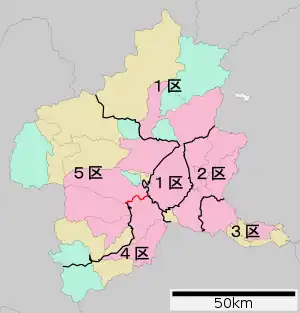 |
| 2nd district[changed 1] | Cities of Isesaki, Kiryū, and Midori District Sawa |
331,700 | Toshiro Ino[14] | LDP | |
| 3rd district[changed 1] | Cities of Ōta and Tatebayashi District of Oura |
320,516 | Hiroyoshi Sasakawa[20] | LDP | |
| 4th district | Cities of Fujioka and part of Takasaki District of Tano |
295,213 | Tatsuo Fukuda[21] | LDP | |
| 5th district[changed 1] | Cities of Annaka, Shibukawa, Tomioka, and part of Takasaki Districts of Agatsuma, Kanra, and Kitagunma |
317,654 | Yūko Obuchi[15] | LDP | |
Ibaraki Prefecture (7 districts)
| District | Areas included | Number of constituents[8] | Current representative | Party represented | Map |
|---|---|---|---|---|---|
| 1st district[changed 1] | Cities of Chikusei, Kasama, Mito, and Sakuragawa
District of Higashiibaraki (Town of Shirosato) |
426,105 | Nobuyuki Fukushima[21] | YK |  |
| 2nd district[changed 1] | Cities of Hokota, Itako, Kashima, Kamisu, Namegata, and Omitama
District of Higashiibaraki (Towns of Ibaraki and Ōarai) |
304,799 | Fukushiro Nukaga[11] | LDP | |
| 3rd district | Cities of Inashiki, Moriya, Ryūgasaki, Toride, and Ushiku | 390,263 | Yasuhiro Hanashi[23] | LDP | |
| 4th district[changed 3][changed 1] | Cities of Hitachinaka, Hitachiōmiya, Hitachiōta, and Naka
District of Kuji |
269,983 | Hiroshi Kajiyama[18] | LDP | |
| 5th district[changed 3] | Cities of Hitachi, Kitaibaraki, and Takahagi
District of Naka |
240,104 | Satoshi Asano[13] | DPFP | |
| 6th district[changed 1] | Cities of Ishioka, Kasumigaura, Tsuchiura, Tsukuba, and Tsukubamirai | 452,377 | Ayano Kunimitsu[18] | LDP | |
| 7th district[changed 1] | Cities of Bandō, Jōsō, Koga, Shimotsuma and Yuki | 330,072 | Keiko Nagaoka[11] | LDP | |
Saitama Prefecture (16 districts)
| District | Areas included | Number of constituents[8] | Current representative | Party represented | Map |
|---|---|---|---|---|---|
| 1st district[changed 1] | Saitama, wards of Midori-ku, Minuma, and Urawa-ku | 382,839 | Hideki Murai[9] | LDP |  |
| 2nd district[changed 1] | Part of city of Kawaguchi | 391,718 | Yoshitaka Shindō[20] | LDP | |
| 3rd district[changed 1] | Cities of Koshigaya and part of Kawaguchi | 381,903 | Hitoshi Kikawada[18] | LDP | |
| 4th district | Cities of Asaka, Niiza, Shiki, and Wakō | 388,488 | Yasushi Hosaka[23] | LDP | |
| 5th district[changed 1] | Saitama, wards of Chūō-ku, Kita-ku, Nishi-ku and Ōmiya-ku | 393,216 | Yukio Edano[17] | CDP | |
| 6th district[changed 1] | Cities of Ageo, Kitamoto, Kōnosu, and Okegawa | 415,349 | Atsushi Ōshima[15] | CDP | |
| 7th district[changed 1] | Cities of Fujimi and Kawagoe | 388,546 | Hideyuki Nakano[11] | LDP | |
| 8th district[changed 1] | Cities of Fujimino, and Tokorozawa | 418,267 | Masahiko Shibayama[20] | LDP | |
| 9th district | Cities of Hannō, Hidaka, Iruma, and Sayama | 404,883 | Taku Ōtsuka[15] | LDP | |
| 10th district | Cities of Higashimatsuyama, Sakado, and Tsurugashima
District of Hiki |
328,662 | Susumu Yamaguchi[16] | LDP | |
| 11th district[changed 1] | Cities of Chichibu, Fukaya, and Honjō | 340,853 | Ryūji Koizumi[18] | LDP | |
| 12th district[changed 1] | Cities of Gyōda, Hanyū, Kazo, and Kumagaya | 372,546 | Toshikazu Morita[9] | CDP | |
| 13th district[changed 1] | Cities of Hasuda, Kuki, Satte, and Shiraoka
Districts of Kita-Adachi, Kitakatsushika (Town of Sugito), and Minamisaitama |
372,386 | Shinako Tsuchiya[10] | LDP | |
| 14th district[changed 1] | Cities of Misato, Sōka, and Yashio | 402,229 | Hiromi Mitsubayashi[9] | LDP | |
| 15th district[changed 1] | Saitama, wards of Minami-ku and Sakura-ku | 411,169 | Ryōsei Tanaka[10] | LDP | |
| 16th district[changed 4] | Saitama, ward of Iwatsuki-ku
Cities of Kasukabe and Yoshikawa District of Kitakatsushika (Town of Matsubushi) |
377,417 | To be determined in 2025 |
Tochigi Prefecture (5 districts)
| District | Areas included | Number of constituents[8] | Current representative | Party represented | Map |
|---|---|---|---|---|---|
| 1st district[changed 1] | Part of city of Utsunomiya
District of Kawachi |
418,287 | Hajime Funada[21] | LDP |  |
| 2nd district[changed 1] | Cities of Kanuma, Nikkō, Sakura, and part of Utsunomiya
District of Shioya |
256,007 | Akio Fukuda[21] | CDP | |
| 3rd district | Cities of Nasukarasuyama, Nasushiobara, Ōtawara, and Yaita
District of Nasu |
240,132 | Kazuo Yana[16] | LDP | |
| 4th district[changed 1] | Cities of Mooka, Oyama, and Shimotsuke
Districts of Haga and Shimotsuga |
357,326 | Tsutomu Sato[20] | LDP | |
| 5th district[changed 1] | Cities of Ashikaga, Sano, and Tochigi | 349,651 | Toshimitsu Motegi[9] | LDP | |
Minami- (Southern) Kanto (22 block seats)
The block constituency for southern Kanto (比例南関東ブロック, hirei minami-Kantō burokku) elects 22 members proportionally. It includes two prefectures in southern Kanto and one in eastern Chubu.
Chiba Prefecture (14 districts)
| District | Areas included | Number of constituents[8] | Current representative | Party represented | Map |
|---|---|---|---|---|---|
| 1st district | Chiba, wards of Chūō-ku, Inage-ku, and Mihama-ku | 433,793 | Kaname Tajima[10] | CDP |  |
| 2nd district[changed 1] | Chiba, ward of Hanamigawa-ku
City Yachiyo |
317,682 | Takayuki Kobayashi[18] | LDP | |
| 3rd district[changed 2] | Chiba, ward of Midori-ku
City of Ichihara |
336,547 | Hirokazu Matsuno[9] | LDP | |
| 4th district[changed 3][changed 1] | Part of the cities of Funabashi, Ichikawa | 405,337 | Yoshihiko Noda[11] | CDP | |
| 5th district[changed 2][changed 1] | Cities of Urayasu, and part of Ichikawa | 413,484 | Arfiya Eri[17] | LDP | |
| 6th district[changed 2][changed 1] | City of Matsudo | 416,215 | Hiromichi Watanabe[12] | LDP | |
| 7th district[changed 1] | Cities of Nagareyama and Noda | 294,531 | Ken Saitō[20] | LDP | |
| 8th district[changed 2][changed 1] | City of Kashiwa | 358,485 | Satoshi Honjo[23] | CDP | |
| 9th district[changed 2] | Chiba, ward of Wakaba-ku
Cities of Sakura, Yachimata, and Yotsukaidō |
407,318 | Soichiro Okuno[15] | CDP | |
| 10th district[changed 1] | Cities of Asahi, Chōshi, Katori, Narita, and Sōsa
Districts of Katori |
329,853 | Motoo Hayashi[23] | LDP | |
| 11th district[changed 1] | Cities of Isumi, Katsuura, Mobara, Ōamishirasato, Tōgane, and Sanmu | 358,264 | Eisuke Mori[9] | LDP | |
| 12th district | Cities of Futtsu, Kamogawa, Kimitsu, Kisarazu, Minamibōsō, Sodegaura, and Tateyama
District of Awa |
379,663 | Yasukazu Hamada[23] | LDP | |
| 13th district[changed 3][changed 5][changed 1] | Cities of Abiko, Inzai, Kamagaya, Shiroi, and Tomisato
District of Iba |
418,355 | Hisashi Matsumoto[9] | LDP | |
| 14th district[changed 4] | Cities of Narashino and part of Funabashi | 414,157 | To be determined in 2025 |
Kanagawa Prefecture (20 districts)
Yamanashi Prefecture (2 districts)
| District | Areas included | Number of constituents[8] | Current representative | Party represented | Map |
|---|---|---|---|---|---|
| District 1[changed 3] | Cities of Kōfu, Nirasaki, Hokuto, Minami-arupusu, Chuo, Kai Districts of Nishiyatsushiro, Minamikoma, and Nakakoma |
424,557 | Shinichi Nakatani[11] | LDP |  |
| District 2[changed 3] | Cities of Yamanashi, Fujiyoshida, Ōtsuki, Tsuru, Fuefuki, Koshu, and Uenohara Districts of Kitatsuru and Minamitsuru |
260,824 | Noriko Horiuchi[23] | LDP |
Tokyo (17 block seats)
The block constituency for Tokyo (比例東京ブロック) elects 17 members proportionally. It covers Tokyo prefecture.
Tokyo Metropolis (30 districts)
Hokurikushin'etsu (11 block seats)
The block constituency for Hokurikushinetsu (北陸信越) elects 11 members proportionally. It combines five prefectures of the Hokuriku and Shin'etsu subregions in northern Chubu.
Fukui Prefecture (2 districts)
| District | Areas included | Number of constituents[8] | Current representative | Party represented | Map |
|---|---|---|---|---|---|
| 1st district[changed 3] | Cities of Awara, Fukui, Katsuyama, Ono, and Sakai
District of Yoshida |
373,417 | Tomomi Inada[14] | LDP |  |
| 2nd district[changed 3] | Cities of Echizen, Obama, Sabae, and Tsuruga
Districts of Imadate, Mikata, Minamikaminaka, Nanjō, Nyū, and Ōi |
261,145 | Tsuyoshi Takagi[10] | LDP | |
Ishikawa Prefecture (3 districts)
| District | Areas included | Number of constituents[8] | Current representative | Party represented | Map |
|---|---|---|---|---|---|
| 1st district | City of Kanazawa | 376,016 | Takuo Komori[18] | LDP |  |
| 2nd district | Cities of Hakusan, Kaga, Komatsu, Nomi, and Nonoichi
District of Nomi |
325,277 | Hajime Sasaki[20] | LDP | |
| 3rd district | Cities of Hakui, Kahoku, Nanao, Suzu, and Wajima. | 241,238 | Shoji Nishida[11] | LDP | |
Niigata Prefecture (5 districts)
| District | Areas included | Number of constituents[8] | Current representative | Party represented | Map |
|---|---|---|---|---|---|
| 1st district[changed 2][changed 1] | Niigata, wards of Chūō-ku, Higashi-ku, and Kōnan-ku
City of Sado |
365,049 | Chinami Nishimura[11] | CDP |  |
| 2nd district[changed 2][changed 1] | Niigata, wards of Minami-ku, Nishi-ku, and Nishikan-ku
Cities of Sanjō, Kamo, and Tsubame Districts of Minamikanbara and Nishikanbara |
402,082 | Kenichi Hosoda | LDP | |
| 3rd district[changed 1] | Niigata, wards of Akiha-ku and Kita-ku
Cities of Agano, Gosen, Murakami, Shibata, and Tainai Districts of Higashikanbara, Iwafune, and Kitakanbara |
381,835 | Hiroaki Saito[20] | LDP | |
| 4th district[changed 1] | Cities of Kashiwazaki, Mitsuke, Nagaoka, and Ojiya | 362,100 | Makiko Kikuta[9] | CDP | |
| 5th district[changed 1] | Cities of Itoigawa, Jōetsu, Minamiuonuma, Myōkō, Uonuma, and Tōkamachi
Districts of Minamiuonuma and Nakauonuma |
352,135 | Ryuichi Yoneyama[16] | CDP | |
Nagano Prefecture (5 districts)
| District | Areas included | Number of constituents[8] | Current representative | Party represented | Map |
|---|---|---|---|---|---|
| 1st district | Cities of Iiyama, Nakano, Suzaka, and part of Nagano
Districts of Kamitakai, Shimominochi, and Shimotakai |
424,275 | Kenta Wakabayashi[12] | LDP |  |
| 2nd district | Cities of Azumino, Matsumoto and Ōmachi, and part of Nagano
Districts of Higashichikuma, Kamiminochi, and Kitaazumi |
381,349 | Mitsu Shimojo[20] | CDP | |
| 3rd district | Cities of Chikuma, Komoro, Saku, Tōmi and Ueda
Districts of Chiisagata, Hanishina, Kitasaku, and Minamisaku |
398,639 | Yosei Ide[14] | LDP | |
| 4th district | Cities of Chino, Okaya, Shiojiri, and Suwa | 239,642 | Shigeyuki Goto[19] | LDP | |
| 5th district | Cities of Iida, Ina and Komagane | 278,839 | Ichiro Miyashita[9] | LDP | |
Toyama Prefecture (3 districts)
| District | Areas included | Number of constituents[8] | Current representative | Party represented | Map |
|---|---|---|---|---|---|
| 1st district | Part of the city of Toyama | 267,663 | Hiroaki Tabata[10] | LDP |  |
| 2nd district | Cities of Kurobe, Namerikawa, Uozu, and part of Toyama
Districts of Nakaniikawa and Shimoniikawa. |
245,898 | Eishun Ueda[25] | LDP | |
| 3rd district | Cities of Himi, Imizu, Nanto, Oyabe, Takaoka, and Tonami | 362,175 | Keiichiro Tachibana[10] | LDP | |
Tokai (21 block seats)
The block constituency for Tokai (東海) elects 21 members proportionally. It covers three prefectures in southern Chubu, as well as one prefecture in Kinki.
Aichi Prefecture (16 districts)
| District | Areas included | Number of constituents[8] | Current representative | Party represented | Map |
|---|---|---|---|---|---|
| 1st district | Nagoya, wards of Higashi, Kita, Nishi, and Naka | 403,902 | Hiromichi Kumada[18] | LDP |  |
| 2nd district | Nagoya, wards of Chikusa, Moriyama and Meitō | 404,844 | Motohisa Furukawa[21] | DPFP | |
| 3rd district | Nagoya, wards of Shōwa, Midori and Tenpaku | 418,407 | Shoichi Kondo[18] | CDP | |
| 4th district | Nagoya, wards of Mizuho, Atsuta, Minato and Minami. | 371,387 | Shozo Kudo[18] | LDP | |
| 5th district[changed 2][changed 1] | Nagoya, wards of Nakamura and Nakagawa.
City of Kiyosu |
350,279 | Kenji Kanda[18] | LDP | |
| 6th district[changed 2][changed 1] | Cities of Kasugai and Seto | 359,295 | Hideki Niwa[11] | LDP | |
| 7th district[changed 1] | Cities of Nagakute, Nisshin, Ōbu, Owariasahi, and Toyoake
District of Aichi |
354,150 | Junji Suzuki[20] | LDP | |
| 8th district | Cities of Handa, Tokoname, Tōkai and Chita
District of Chita |
437,388 | Tadahiko Ito[14] | LDP | |
| 9th district[changed 1] | Cities of Ama, Aisai, Inazawa, Tsushima, and Yatomi
District of Ama |
383,431 | Yasumasa Nagasaka[11] | LDP | 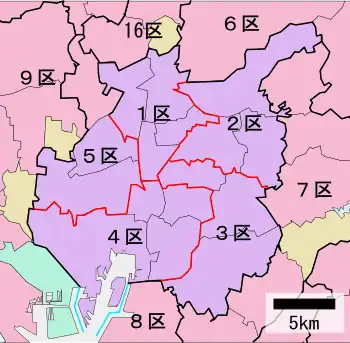 |
| 10th district[changed 2][changed 1] | Cities of Ichinomiya and Iwakura | 354,248 | Tetsuma Esaki[17] | LDP | |
| 11th district[changed 1] | Cities of Miyoshi and Toyota | 386,121 | Tetsuya Yagi[16] | LDP | |
| 12th district | Cities of Okazaki and Nishio | 445,465 | Kazuhiko Shigetoku[20] | CDP | |
| 13th district | Cities of Hekinan, Kariya, Anjō, Chiryū, and Takahama | 424,402 | Kensuke Onishi[15] | CDP | |
| 14th district[changed 1] | Cities of Toyokawa, Gamagōri, and Shinshiro
District of Nukata and Kitashitara |
294,065 | Soichiro Imaeda[14] | LDP | |
| 15th district | Cities of Toyohashi and Tahara | 347,576 | Yukinori Nemoto[11] | LDP | |
| 16th district[changed 4] | Cities of Kitanagoya, Komaki, Kōnan, and Inuyama
District of Nishikasugai and Niwa |
393,120 | To be determined in 2025 |
Gifu Prefecture (5 districts)
| District | Areas included | Number of constituents[8] | Current representative | Party represented | Map |
|---|---|---|---|---|---|
| 1st district[changed 1] | City of Gifu | 336,264 | Seiko Noda[11] | LDP |  |
| 2nd district | Cities of Ōgaki and Kaizu | 298,922 | Yasufumi Tanahashi[10] | LDP | |
| 3rd district[changed 1] | Cities of Hashima, Kakamigahara, Mino, Mizuho, Motosu, Seki, and Yamagata | 411,722 | Yoji Muto[9] | LDP | |
| 4th district | Cities of Gero, Gujō, Hida, Kani, Minokamo, and Takayama | 327,816 | Shumpei Kaneko[18] | LDP | |
| 5th district | Cities of Ena, Mizunami, Nakatsugawa, Tajimi, and Toki | 271,830 | Keiji Furuya[21] | LDP | |
Mie Prefecture (4 districts)
| District | Areas included | Number of constituents[8] | Current representative | Party represented | Map |
|---|---|---|---|---|---|
| 1st district | Cities of Matsuaka and Tsu | 358,042 | Norihisa Tamura[10] | LDP | 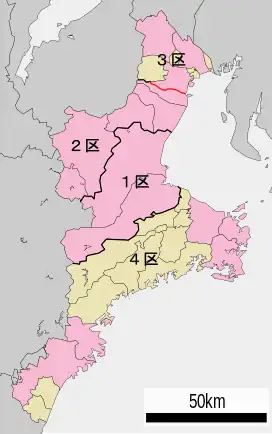 |
| 2nd district | Cities of Iga, Kameyama, Nabari, Suzuka, and part of Yokkaichi | 407,181 | Hideto Kawasaki[18] | LDP | |
| 3rd district | Cities of Inabe, Kuwana, and part of Yokkaichi | 414,798 | Katsuya Okada[15] | CDP | |
| 4th district | Cities of Ise, Kumano, Owase, Toba, and Shima
Disitricts of Kitamuro, Minamimuro, Taki, and Watarai |
294,027 | Eikei Suzuki[20] | LDP | |
Shizuoka Prefecture (8 districts)
| District | Areas included | Number of constituents[8] | Current representative | Party represented | Map |
|---|---|---|---|---|---|
| 1st district[changed 1] | Shizuoka, wards of Aoi and Suruga | 386,430 | Yōko Kamikawa[18] | LDP |  |
| 2nd district[changed 1] | Cities of Fujieda, Makinohara, Shimada, and Yaizu
District of Haibara |
378,801 | Tatsunori Ibayashi[14] | LDP | |
| 3rd district[changed 1] | Cities Fukuroi, Iwata, Kakegawa, Kikugawa, and Omaezaki
District of Shūchi |
375,422 | Nobuhiro Koyama[18] | CDP | |
| 4th district[changed 1] | Shizuoka, ward of Shimizu-ku
Cities of Fujinomiya and part of Fuji |
318,744 | Yoichi Fukazawa[21] | LDP | |
| 5th district[changed 1] | Cities of Gotemba, Mishima, Susono, and part of Fuji | 455,231 | Goshi Hosono[23] | LDP | |
| 6th district[changed 1] | Cities of Atami, Itō, Izu, Izunokuni, Numazu, and Shimoda
Districts |
434,785 | Takaaki Katsumata[18] | LDP | |
| 7th district[changed 1] | Hamamatsu, wards of Hamakita, Kita-ku, Nishi-ku, and Tenryū
City of Kosai |
316,233 | Minoru Kiuchi[18] | LDP | |
| 8th district[changed 1] | Hamamatsu, wards of Higashi, Minami, and Naka | 382,752 | Kentaro Gemma[19] | CDP | |
Kinki/Kansai (28 block seats)
The block constituency for Kinki (Kansai) (近畿) elects 29 members proportionally. It corresponds to the Kinki region minus Mie Prefecture.
Hyōgo Prefecture (12 districts)
| District | Areas included | Number of constituents[8] | Current representative | Party represented | Map |
|---|---|---|---|---|---|
| 1st district | Kobe, wards of Chūō-ku, Higashinada-ku, and Nada-ku | 394,037 | Nobuhiko Isaka[14] | CDP |  |
| 2nd district | Kobe, wards of Hyōgo-ku, Kita-ku, and Nagata-ku
Part of the city of Nishinomiya |
385,407 | Kazuyoshi Akaba[13] | Komeito | |
| 3rd district | Kobe, wards of Suma-ku and Tarumi-ku | 313,392 | Yoshihiro Seki[20] | LDP | |
| 4th district | Kobe, ward of Nishi-ku
Cities of Kasai, Katō, Miki, Nishiwaki, and Ono District of Taka |
419,227 | Hisayuki Fujii[21] | LDP | |
| 5th district[changed 1] | Cities of Asago, Sanda, Tamba, Tamba-Sasayama, Toyooka, Yabu, and part of Kawanishi | 381,054 | Koichi Tani[10] | LDP | |
| 6th district[changed 1] | Cities of Itami, Takarazuka, and part of Kawanishi | 449,512 | Koichiro Ichimura[14] | Nippon Ishin | |
| 7th district | Cities of Ashiya and part of Nishinomiya | 443,422 | Kenji Yamada[16] | LDP | |
| 8th district | City of Amagasaki | 386,380 | Hiromasa Nakano[11] | Komeito | |
| 9th district | Cities of Akashi, Awaji, Minamiawaji, and Sumoto | 363,654 | Yasutoshi Nishimura[11] | LDP | |
| 10th district | Cities of Kakogawa and Takasago
District of Kako |
347,377 | Kisaburo Tokai[10] | LDP | |
| 11th district | Part of the city of Himeji | 399,004 | Takeaki Matsumoto[9] | LDP | |
| 12th district | Cities of Aioi, Ako, Shiso, Tatsuno, and part of Himeji | 282,431 | Tsuyoshi Yamaguchi[16] | LDP | |
Kyoto Prefecture (6 districts)
| District | Areas included | Number of constituents[8] | Current representative | Party represented | Map |
|---|---|---|---|---|---|
| 1st district | Kyoto, wards of Kamigyō-ku, Kita-ku, Nakagyō-ku, Minami-ku, and Shimogyō-ku | 390,269 | Yasushi Katsume[18] | LDP |  |
| 2nd district | Kyoto, wards of Higashiyama-ku, Sakyō-ku, and Yamashina-ku | 263,524 | Seiji Maehara[9] | DPFP | |
| 3rd district | Kyoto, ward of Fushimi-ku
Cities of Mukō and Nagaokakyō District of Otokuni |
353,363 | Kenta Izumi[14] | CDP | |
| 4th district | Kyoto, wards of Nishikyō-ku and Ukyō-ku | 394,845 | Keiro Kitagami[18] | YK | |
| 5th district | Vities of Ayabe, Fukuchiyama, Kyōtango, Maizuru, and Miyazu
District of Yosa |
236,343 | Taro Honda[23] | LDP | |
| 6th district | Cities of Joyo, Kizugawa, Kyōtanabe, Uji, and Yawata | 459,643 | Kazunori Yamanoi[16] | CDP | |
Nara Prefecture (3 districts)
| District | Areas included | Number of constituents[8] | Current representative | Party represented | Map |
|---|---|---|---|---|---|
| 1st district | Cities of Ikoma and part of Nara | 394,347 | Sumio Mabuchi[9] | CDP | 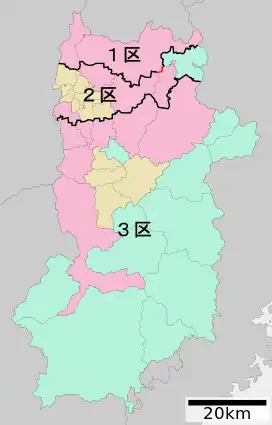 |
| 2nd district | Cities of Kashiba, Tenri, Yamatokōriyama, and part of Nara
Districts of Ikoma, Kitakatsuragi, Shiki, and Yamabe |
382,819 | Sanae Takaichi[10] | LDP | |
| 3rd district | Cities of Gojō, Gose, Kashihara, Katsuragi, Sakurai, Uda and Yamatotakada | 352,656 | Taido Tanose[10] | LDP | |
Osaka Prefecture (19 districts)
| District | Areas included | Number of constituents[8] | Current representative | Party represented | Map |
|---|---|---|---|---|---|
| 1st district | Osaka, wards of Chūō-ku, Higashinari-ku , Minato-ku, Naniwa-ku, Nishi-ku, and Tennōji-ku | 433,378 | Hidetaka Inoue[14] | Nippon Ishin |  |
| 2nd district | Osaka, wards of Abeno-ku, Higashisumiyoshi-ku, Hirano-ku, and Ikuno-ku | 445,958 | Tadashi Morishima[9] | Nippon Ishin | |
| 3rd district | Osaka, wards of Nishinari-ku, Suminoe-ku, Sumiyosho-ku, and Taisho-ku | 365,973 | Shigeki Sato[20] | Komeito | |
| 4th district | Osaka, wards of Fukushima-ku, Joto-ku, Kita-ku, and Miyakojima-ku | 410,669 | Teruo Minobe[9] | Nippon Ishin | |
| 5th district | Osaka, wards of Higashiyodogawa-ku, Konohana-ku, Nishiyodogawa-ku, and Yodogawa-ku | 432,729 | Toru Kunishige[18] | Komeito | |
| 6th district | Osaka, wards of Asahi-ku and Tsurumi-ku | 390,026 | Shinichi Isa[14] | Komeito | |
| 7th district | Cities of Settsu and Suita | 385,703 | Takemitsu Okushita[15] | Nippon Ishin | |
| 8th district[changed 1] | Cities of Ikeda and Toyonaka | 423,902 | Joji Uruma[25] | Nippon Ishin | |
| 9th district[changed 1] | Cities of Ibaraki and Minoo
District of Toyono |
371,891 | Yasushi Adachi[13] | Nippon Ishin | |
| 10th district | City of Takatsuki
District of Mishima |
320,615 | Taku Ikeshita[14] | Nippon Ishin | |
| 11th district | Cities of Hirakata and Katano | 398,982 | Hiroshi Nakatsuka[11] | Nippon Ishin |  |
| 12th district | Cities of Daitō, Neyagawa, and Shijōnawate | 339,048 | Fumitake Fujita[21] | Nippon Ishin | |
| 13th district | City of Higashiōsaka | 400,456 | Ryohei Iwatani[14] | Nippon Ishin | |
| 14th district | Cities of Fujiidera, Habikino, Kashiwara, and Yao | 420,979 | Hitoshi Aoyagi[13] | Nippon Ishin | |
| 15th district | Sakai, ward of Mihara-ku
Cities of Kawachinagano, Matsubara, Ōsakasayama, and Tondabayashi District of Minamikawachi |
388,103 | Yasuto Urano[25] | Nippon Ishin | |
| 16th district | Sakai, wards of Higashi-ku, Kita-ku, and Sakai-ku | 326,786 | Kazuo Kitagawa[18] | Komeito | |
| 17th district | Sakai, wards of Minami-ku, Naka-ku, and Nishi-ku | 329,205 | Nobuyuki Baba[26] | Nippon Ishin | |
| 18th district | Cities of Izumi, Izumiōtsu, Kishiwada, and Takaishi
District of Senboku |
433,984 | Takashi Endo[17] | Nippon Ishin | |
| 19th district | Cities of Hannan, Izumisano, Kaizuka, and Sennan
District of Sennan |
303,724 | Nobuhisa Ito[14] | Nippon Ishin | |
Shiga Prefecture (3 districts)
| District | Areas included | Number of constituents[8] | Current representative | Party represented | Map |
|---|---|---|---|---|---|
| 1st district | Cities of Ōtsu and Takashima | 325,422 | Toshitaka Ooka[15] | LDP |  |
| 2nd district[changed 2][changed 1] | Cities of Higashiōmi, Maibara, Nagahama, Hikone, and Ōmihachiman | 437,139 | Kenichiro Ueno[25] | LDP | |
| 3rd district[changed 2][changed 1] | Cities of Kōka, Konan, Kusatsu, Moriyama, Rittō and Yasu | 392,383 | Nobuhide Takemura[10] | LDP | |
Wakayama Prefecture (2 districts)
| District | Areas included | Number of constituents[8] | Current representative | Party represented | Map |
|---|---|---|---|---|---|
| 1st district[changed 1] | City of Iwade, Kinokawa, and Wakayama | 403,217 | Yumi Hayashi[23] | Nippon Ishin |  |
| 2nd district[changed 3][changed 1] | Cities of Arida, Gobō, Hashimoto, Kainan, Shingū, and Tanabe
Districts of Arida, Hidaka, Higashimuro, Ito, Kaisō, and Nishimuro |
392,379 | Masatoshi Ishida[14] | LDP | |
Chugoku (11 block seats)
The block constituency for Chugoku (中国) elects 11 members proportionally. It corresponds to the Chugoku region.
Hiroshima Prefecture (6 districts)
| District | Areas included | Number of constituents[8] | Current representative | Party represented | Map |
|---|---|---|---|---|---|
| 1st district[changed 1] | Hiroshima, wards of Higashi-ku, Minami-ku, and Naka-ku | 410,425 | 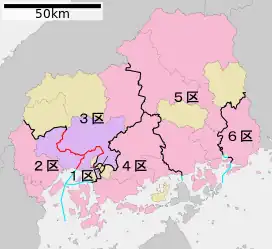 | ||
| 2nd district[changed 1] | Hiroshima, wards of Nishi-ku and Saeki-ku
Cities of Hatsukaichi, and Ōtake |
391,029 | Hiroshi Hiraguchi[23] | LDP | |
| 3rd district[changed 1] | Hiroshima, wards of Aki-ku, Asakita-ku and Asaminami-ku | 423,244 | |||
| 4th district[changed 1] | Cities of Etajima, Higashihiroshima, Kure, and Takehara | 398,489 | |||
| 5th district[changed 1] | Fuchū, Mihara, Miyoshi, Onomichi, and Shōbara | 309,901 | Minoru Terada[10] | LDP | |
| 6th district[changed 1] | City of Fukuyama | 381,074 | |||
Okayama Prefecture (4 districts)
| District | Areas included | Number of constituents[8] | Current representative | Party represented | Map |
|---|---|---|---|---|---|
| 1st district[changed 1] | Okayama, ward of Kita-ku | 329,469 | Ichiro Aisawa[13] | LDP |  |
| 2nd district[changed 1] | Okayama, ward of Higashi-ku, Minami-ku, and Naka-ku | 417,620 | Takashi Yamashita[16] | LDP | |
| 3rd district[changed 1] | Cities of Asakuchi, Ibara, Kasaoka, Mimasaka, Maniwa, Niimi, Sōja, Takahashi, and Tsuyama
Districts of Aida, Asakuchi, Katsuta, Kume, Maniwa, Oda, and Tomata |
410,597 | Shojiro Hiranuma[23] | LDP | |
| 4th district[changed 1] | City of Kurashiki
District of Tsukubo |
405,558 | Gaku Hashimoto[23] | LDP | |
Shimane Prefecture (2 districts)
| District | Areas included | Number of constituents[8] | Current representative | Party represented | Map |
|---|---|---|---|---|---|
| 1st district[changed 2][changed 1] | Cities of Matsue, Unnan, and Yasugi | 259,179 | Hiroyuki Hosoda[23] | Independent |  |
| 2nd district[changed 2][changed 1] | Cities Gōtsu, Hamada, Izumo, Masuda, and Ōda | 296,468 | Yasuhiro Takami[10] | LDP | |
Tottori Prefecture (2 districts)
| District | Areas included | Number of constituents[8] | Current representative | Party represented | Map |
|---|---|---|---|---|---|
| 1st district[changed 3] | Cities of Kurayoshi and Tottori | 229,371 | Shigeru Ishiba[14] | LDP |  |
| 2nd district[changed 3] | Cities of Sakaiminato and Yonago
Districts of Hino, Saihaku, and Tōhaku (Towns of Hokuei, Kotoura, and Yurihama) |
232,955 | Ryosei Akazawa[13] | LDP | |
Yamaguchi Prefecture (3 districts)
| District | Areas included | Number of constituents[8] | Current representative | Party represented | Map |
|---|---|---|---|---|---|
| 1st district[changed 1] | Cities of Hōfu, Ube, and Yamaguchi | 391,474 | Masahiko Kōmura[18] | LDP | 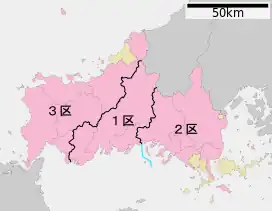 |
| 2nd district[changed 1] | Cities of Hikari, Iwakuni, Kudamatsu, Shūnan, and Yanai | 386,937 | Nobuchiyo Kishi[18] | LDP | |
| 3rd district[changed 1] | Cities of Hagi, Mine, Nagato, Sanyo-Onoda, and Shimonoseki
District of Abu |
355,510 | Yoshimasa Hayashi[23] | LDP | |
Shikoku (6 block seats)
The block constituency for Shikoku (比例四国ブロック) elects 6 members proportionally. It corresponds to the Shikoku region.
Ehime Prefecture (3 districts)
| District | Areas included | Number of constituents[8] | Representative | Party represented | Map |
|---|---|---|---|---|---|
| District 1[changed 1] | City of Matsuyama | 426,322 | Akihisa Shiozaki[20] | LDP |  |
| District 2[changed 3][changed 1] | Cities of Imabari, Niihama, Saijō, and Shikokuchūō
District of Ochi |
393,597 | Seiichiro Murakami[9] | LDP | |
| District 3[changed 3][changed 1] | Cities Iyo, Ōzu, Seiyo, Uwajima, Tōon, and Yawatahama
Districts Iyo, Kamiukena, Kita, Kitauwa, Minamiuwa, and Nishiuwa |
314,289 | Takumi Ihara[14] | LDP |
Kagawa Prefecture (3 districts)
| District | Areas included | Number of constituents[8] | Current representative | Party represented | Map |
|---|---|---|---|---|---|
| 1st district | Part of the city of Takamatsu | 312,992 | Junya Ogawa[15] | CDP |  |
| 2nd district | Cities of Higashikagawa, Sakaide, Sanuki and parts of Takamatsu and Marugame | 256,773 | Yuichiro Tamaki[10] | DPFP | |
| 3rd district | Cities Kan'onji, Mitoyo, Zentsuji, and part of Marugame
District of Nakatado |
238,016 | Keitaro Ohno[15] | LDP | |
Kōchi Prefecture (2 districts)
| District | Areas included | Number of constituents[8] | Current representative | Party represented | Map |
|---|---|---|---|---|---|
| 1st district[changed 2][changed 3] | Cities of Aki, Kami, Kōnan, Muroto, Nankoku, and part of Kōchi | 308,938 | Gen Nakatani[11] | LDP |  |
| 2nd district[changed 2][changed 3] | Cities of Shimanto, Susaki, Sukumo and Tosa, Tosashimizu, and part of Kōchi | 284,670 | Masanao Ozaki[15] | LDP | |
Tokushima Prefecture (2 districts)
| District | Areas included | Number of constituents[8] | Current representative | Party represented | Map |
|---|---|---|---|---|---|
| 1st district[changed 2][changed 3] | Cities of: Tokushima, Komatsushima, and Anan. | 360,095 | Hirobumi Niki[11] | YK | 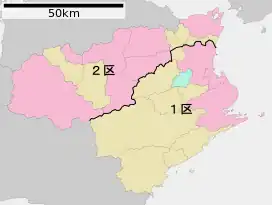 |
| 2nd district[changed 2][changed 3] | Cities of: Awa, Yoshinogawa, Naruto, Mima, and Miyoshi. | 258,564 | Shunichi Yamaguchi[16] | LDP | |
Kyūshū (20 block seats)
The block constituency for Kyūshū (九州) elects 21 members proportionally. It includes all the prefectures on Kyūshū island, as well as Okinawa Prefecture.
Fukuoka Prefecture (11 districts)
| District | Areas included | Number of constituents[8] | Current representative | Party represented | Map |
|---|---|---|---|---|---|
| 1st district[changed 1] | Fukuoka, wards of Hakata-ku and part of Higashi-ku | 431,653 | Takahiro Inoue[14] | LDP |  |
| 2nd district | Fukuoka, wards of Chūō-ku and part of Jonan-ku and Minami-ku | 453,775 | Makoto Oniki[15] | LDP | |
| 3rd district | Fukuoka, wards of Nishi-ku, Sawara-ku, and part of Jonan-ku
City of Itoshima |
446,205 | Atsushi Koga[18] | LDP | |
| 4th district[changed 1] | Fukuoka, part of the ward of Higashi-ku | 398,041 | Hideki Miyauchi[9] | LDP | |
| 5th district | Fukuoka, part of the ward of Minami-ku
Cities of Asakura, Chikushino, Dazaifu, Kasuga, Nakagawa and Onojo District of Asakura |
456,331 | Kaname Tsutsumi[10] | CDP | |
| 6th district | Cities of Kurume, Ogori, Okawa, and Ukiha | 373,877 | Jiro Hatoyama[23] | LDP | |
| 7th district | Cities of Chikugo, Miyama, Omuta, Yame, and Yanagawa
District of Yame |
286,562 | Satoshi Fujimaru[21] | LDP | |
| 8th district | Cities of Iizuka, Kama, Miyawaka, Nakama, and Nogata | 347,369 | Tarō Asō[13] | LDP | |
| 9th district | Kitakyushu, wards of Tobata-ku, Wakamatsu-ku, Yahatahigashi-ku, and Yahatanishi-ku | 378,490 | Rintaro Ogata[15] | Komeito | |
| 10th district | Kitakyushu, wards of Kokurakita-ku, Kokuraminami-ku, and Moji-ku | 406,620 | Takashi Kii[18] | CDP | |
| 11th district | Cities of Buzen, Tagawa, and Yukuhashi | 255,347 | Ryota Takeda[10] | LDP | |
Kagoshima Prefecture (4 districts)
| District | Areas included | Number of constituents[8] | Current representative | Party represented | Map |
|---|---|---|---|---|---|
| 1st district | Part of the city of Kagoshima
District of Kagoshima |
357,284 | Takuma Miyaji[9] | LDP |  |
| 2nd district | Cities of Amami, Ibusuki, Makurazaki, Minamisatsuma, Minamikyushu, and part of Kagoshima
District of Ōshima |
334,582 | Satoshi Mitazono[9] | LDP | |
| 3rd district | Cities of Aira, Akune, Hioki, Ichikikushikino, Isa, Izumi, and Satsumasendai | 316,469 | Takeshi Noma[11] | CDP | |
| 4th district | Cities of Kanoya, Kirishima, Nishinoomote, Shibushi, Soo, and Tarumizu | 323,373 | Hiroshi Moriyama[9] | LDP | |
Kumamoto Prefecture (4 districts)
| District | Areas included | Number of constituents[8] | Current representative | Party represented | Map |
|---|---|---|---|---|---|
| 1st district | Kumamoto, wards of Chuo, Higashi, and Kita | 422,072 | Minoru Kihara[18] | LDP |  |
| 2nd district | Kumamoto, wards of Nishi and Minami | 313,172 | Daisuke Nishino[11] | LDP | |
| 3rd district | Cities of Kochi, Aso, Kikuchi, and Yamaga
Districts of Aso, Kamimashiki, and Kikuchi |
315,454 | Tetsushi Sakamoto[10] | LDP | |
| 4th district[changed 3] | Cities of Amakusa, Hitoyoshi, Kami-Amakusa, Minamata, Uki, Uto, and Yatsushiro
Districts of Ashikita, Amakusa, Kuma, Shimomashiki, and Yatsushiro |
399,867 | Yasushi Kaneko[18] | LDP | |
Miyazaki Prefecture (3 districts)
| District | Areas included | Number of constituents[8] | Current representative | Party represented | Map |
|---|---|---|---|---|---|
| Miyazaki 1st | City of Miyazaki
District of Higashimorokata |
354,398 | So Watanabe[12] | CDP |  |
| Miyazaki 2nd | Cities of Hyuga, Nobeoka, and Saito
Districts of Higashiusuki, Koyu, and Nishiusuki |
270,284 | Taku Etō[17] | LDP | |
| Miyazaki 3rd | Cities of Ebino, Kobayashi, Kushima, Miyakonojo, and Nichinan
Districts of Kitamorokata and Nishimorokata |
271,813 | Yoshihisa Furukawa[21] | LDP | |
Nagasaki Prefecture (3 districts)
| District | Areas included | Number of constituents[8] | Current representative | Party represented | Map |
|---|---|---|---|---|---|
| 1st district[changed 1] | City of Nagasaki | 344,579 | Hideko Nishioka[11] | DPFP |  |
| 2nd district[changed 1] | Cities of Iki, Isahaya, Minamishimabara, Omura, Shimabara, Unzen, and Tsushima
District of Nishisonogi |
403,812 | Ryusho Kato[18] | LDP | |
| 3rd district[changed 3][changed 1] | Cities of Gotō, Hirado, Matsuura, Saikai, and Sasebo
Districts of Higashisonogi, Kitamatsuura, and Minamimatsura |
357,963 | Yaichi Tanigawa[10] | LDP | |
Ōita Prefecture (3 districts)
| District | Areas included | Number of constituents[8] | Current representative | Party represented | Map |
|---|---|---|---|---|---|
| 1st district | Part of the city of Ōita | 386,368 | Shuji Kira[18] | YK |  |
| 2nd district | Cities of Bungo-ōno, Hita, Saiki, Taketa, Tsukumi, Yufu, Usuki, and part of Ōita
District of Kusu |
264,423 | Seishirō Etō[17] | LDP | |
| 3rd district | Cities of Beppu, Bungotakada, Kitsuki, Nakatsu, Kunisaki, and Usa
Districts of Hayami, and Higashikunisaki |
299,659 | Takeshi Iwaya[14] | LDP | |
Okinawa Prefecture (4 districts)
| District | Areas included | Number of constituents[8] | Current representative | Party represented | Map |
|---|---|---|---|---|---|
| 1st district[changed 2] | City of Naha
District of Shimajiri (Town of Kumejima and villages of Aguni, Kitadaitō, Minamidaitō, Tokashiki, Tonaki, and Zamami) |
268,018 | Seiken Akamine[13] | Communist |  |
| 2nd district[changed 2] | Cities of Ginowan and Urasoe
District of Nakagami |
296,016 | Kunio Arakaki[13] | CDP | |
| 3rd district[changed 2] | Cities of Nago, Okinawa, Uruma
Districts of Kunigami and Shimajiri (Villages of Iheya and Izena) |
318,484 | Aiko Shimajiri[20] | LDP | |
| 4th district[changed 5] | Cities of Miyakojima, Ishigaki, Itoman, Tomigusuku and Nanjō.
Districts of: Miyako, Yaeyama, Shimajiri (Towns of Haebaru, Yaese, and Yonabaru) |
296,996 | Kōsaburō Nishime[11] | LDP | |
Saga Prefecture (2 districts)
| District | Areas included | Number of constituents[8] | Current representative | Party represented | Map |
|---|---|---|---|---|---|
| 1st district[changed 2][changed 3] | Cities of Kanzaki, Saga, and Tosu | 333,869 | Kazuhiro Haraguchi[23] | CDP |  |
| 2nd district[changed 2][changed 3] | Cities of Kashima, Ogi, Imari, Karatsu, Ureshino, Takeo, and Taku.
Districts of Fujitsu, Kishima, Higashimatsuura, and Nishimatsuura. |
338,720 | Hiroshi Ogushi[15] | CDP | |
See also
- List of districts of the House of Councillors of Japan
- House of Representatives (Japan)
- List of proportional representation blocks of the House of Representatives of Japan
- Proportional representation
Notes
- 1 2 3 4 5 6 7 8 9 10 11 12 13 14 15 16 17 18 19 20 21 22 23 24 25 26 27 28 29 30 31 32 33 34 35 36 37 38 39 40 41 42 43 44 45 46 47 48 49 50 51 52 53 54 55 56 57 58 59 60 61 62 63 64 65 66 67 68 69 70 71 72 73 74 75 76 77 78 79 80 81 82 83 84 85 86 87 88 89 90 91 92 93 94 95 96 97 98 99 100 101 102 103 104 105 106 107 108 109 110 111 112 113 114 115 116 117 118 119 120 121 122 123 124 125 126 127 128 129 130 131 132 Redistricted in 2022 (First effective in the 2025 Japanese General Election)
- 1 2 3 4 5 6 7 8 9 10 11 12 13 14 15 16 17 18 19 20 21 22 23 24 25 26 27 28 29 30 31 32 Redistricted in 2002 (first effective in the 2003 House of Representatives election)
- 1 2 3 4 5 6 7 8 9 10 11 12 13 14 15 16 17 18 19 20 21 22 23 24 25 Redistricted in 2013 (first effective in the 47th House of Representatives election)
- 1 2 3 4 5 6 7 8 9 10 Created in 2022 (First effective in the 2025 Japanese General Election)
- 1 2 3 Created in the 2002 reapportionment (first effective in the 2003 House of Representatives election)
References
- ↑ "Japanese Pass Bills On Electoral Reform". The New York Times. 3 November 1993. Retrieved 2008-08-09.
- ↑ CRS: Issue Brief IB93100 in the Government Document Digital Collection of the University of North Texas
- ↑ MIC: 衆議院小選挙区の区割りの改定等について
- ↑ MIC: 衆議院小選挙区の区割りの改定等について
- ↑ MIC: 衆議院比例代表選出議員の定数削減について
- ↑ MIC: 衆議院小選挙区の区割りの改定等について
- ↑ NHK Senkyo Web: 衆院小選挙区 区割り見直し 改正公選法が成立
- 1 2 3 4 5 6 7 8 9 10 11 12 13 14 15 16 17 18 19 20 21 22 23 24 25 26 27 28 29 30 31 32 33 34 35 36 37 38 39 40 41 42 43 44 45 46 47 "総務省|令和4年9月1日現在選挙人名簿及び在外選挙人名簿登録者数". 総務省 (in Japanese). Retrieved 2023-01-28.
- 1 2 3 4 5 6 7 8 9 10 11 12 13 14 15 16 17 18 19 20 21 22 23 24 25 26 27 "Members M_The House of Representatives,Japan". www.shugiin.go.jp. Retrieved 2023-01-28.
- 1 2 3 4 5 6 7 8 9 10 11 12 13 14 15 16 17 18 19 20 21 22 23 24 25 26 27 28 "Members T_The House of Representatives,Japan". www.shugiin.go.jp. Retrieved 2023-01-28.
- 1 2 3 4 5 6 7 8 9 10 11 12 13 14 15 16 17 18 19 20 21 22 23 24 25 26 "Members N_The House of Representatives,Japan". www.shugiin.go.jp. Retrieved 2023-01-28.
- 1 2 3 4 5 "Members W_The House of Representatives,Japan". www.shugiin.go.jp. Retrieved 2023-01-28.
- 1 2 3 4 5 6 7 8 9 10 11 12 13 "Members A_The House of Representatives,Japan". www.shugiin.go.jp. Retrieved 2023-01-28.
- 1 2 3 4 5 6 7 8 9 10 11 12 13 14 15 16 17 18 19 20 21 22 23 24 25 "Members I_The House of Representatives,Japan". www.shugiin.go.jp. Retrieved 2023-01-28.
- 1 2 3 4 5 6 7 8 9 10 11 12 13 14 15 16 17 18 19 20 21 "Members O_The House of Representatives,Japan". www.shugiin.go.jp. Retrieved 2023-01-28.
- 1 2 3 4 5 6 7 8 9 10 11 12 13 14 "Members Y_The House of Representatives,Japan". www.shugiin.go.jp. Retrieved 2023-01-28.
- 1 2 3 4 5 6 7 8 9 "Members E_The House of Representatives,Japan". www.shugiin.go.jp. Retrieved 2023-01-28.
- 1 2 3 4 5 6 7 8 9 10 11 12 13 14 15 16 17 18 19 20 21 22 23 24 25 26 27 28 29 30 31 32 33 34 35 36 37 38 "Members K_The House of Representatives,Japan". www.shugiin.go.jp. Retrieved 2023-01-28.
- 1 2 3 4 "Members G_The House of Representatives,Japan". www.shugiin.go.jp. Retrieved 2023-01-28.
- 1 2 3 4 5 6 7 8 9 10 11 12 13 14 15 16 17 18 19 20 21 22 23 24 25 "Members S_The House of Representatives,Japan". www.shugiin.go.jp. Retrieved 2021-06-11.
- 1 2 3 4 5 6 7 8 9 10 11 12 13 14 "Members F_The House of Representatives,Japan". www.shugiin.go.jp. Retrieved 2021-08-15.
- ↑ "Members D_The House of Representatives,Japan". www.shugiin.go.jp. Retrieved 2023-06-22.
- 1 2 3 4 5 6 7 8 9 10 11 12 13 14 15 16 17 18 "Members H_The House of Representatives,Japan". www.shugiin.go.jp. Retrieved 2021-06-11.
- ↑ "Members R_The House of Representatives,Japan". www.shugiin.go.jp. Retrieved 2023-06-22.
- 1 2 3 4 "Members U_The House of Representatives,Japan". www.shugiin.go.jp. Retrieved 2023-06-22.
- ↑ "Members B_The House of Representatives,Japan". www.shugiin.go.jp. Retrieved 2023-06-22.
External links
- MIC, e-Gov legal database: 公職選挙法 (kōshoku senkyo hō), Law No. 100 of April 25, 1950 (the three appended tables list the area/number of seats for all electoral districts to both Houses of the National Diet); MOJ, Japanese Law Translation Database: Public Offices Election Act ([by definition unofficial] translation to English, if available)





